

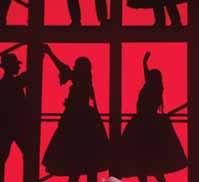



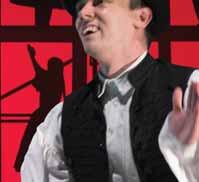






李斯特、科達伊、巴托克,加上一點 兒爵士樂;搖曳多姿的土風舞,優 雅瀟灑的芭蕾舞;流光溢彩的剛勁繪 畫;訴說歷史的珍貴文物──是次中國 2007/2008年度匈牙利文化季,以「自 由與愛情」為主題,聚焦匈牙利文化, 將匈牙利文化之精華帶給中國觀眾。我 們堅信藝術的魅力:如一條無形紐帶, 將藝術家和觀眾連起來,彼此達致深厚 理解。
北京和上海的觀眾體會過這樣的魅力 時刻──而香港的觀眾亦享受到同樣魅 力。音樂天才安德拉斯.席夫和繪畫大 家拉斯洛.費赫,看來註定要在香港一 同亮相。同時,匈牙利國立民族舞蹈團 將帶給您保存完好的匈牙利民族傳統舞 蹈。著名的香港藝術節負責席夫和民族 舞蹈團的演出事宜,我們衷心感謝。沒 有藝術節同仁的專業知識,我們不可能 如此順利走近香港觀眾。參加此次藝術 節,我們深感自豪,並希望自此形成傳 統,今後繼續亮相於藝術節舞台。
中國 2007/2008 年度匈牙利文化季將 於 6 月在深圳落幕。事實證明,匈牙利 藝術極具文化價值,現在能深受中國人 民歡迎,正如我們所願。我們的藝術家 又應邀回來,與中方聯手締造新作,如 有名的李斯特音樂學院,會與北京及上 海的音樂學院合作。中國人民已向匈牙 利藝術敞開心扉,希望兩者自始建立長 久關係。
匈牙利教育及文化部
國際事務大臣
姬蒂蓮.寶乍爾

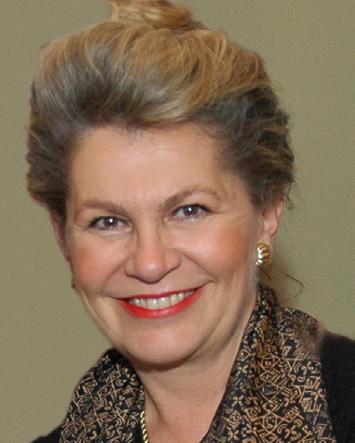
our culture Chinese
Liszt, Kodály, Bartók and a bit of jazz; sweeping folk dances and graceful ballet; paintings in dashing colours; and precious objects with messages of the past: we have brought the crème de la crème of our culture to Chinese audiences during ‘Liberty, Love!,’ Hungarian Culture in Focus, Hungarian Season in China 2007/2008. We believe in the magic of art: the invisible bond that unites artists and audiences in deep, intimate understanding.
Such moments of magic were created in the Beijing and Shanghai auditoriums – and the audiences in Hong Kong are treated to the same magic. András Schiff, the genius of sound and László Fehér, the genius of images, seem to have been fated to appear together in Hong Kong, while the Hungarian State Folk Ensemble is bringing you the well-preserved dance traditions of our nation. The renowned Hong Kong Arts Festival deserves our gratitude for hosting the Schiff and Folk Ensemble events: without their expertise we could not have reached the Hong Kong audience with such success. We are proud to be part of this Festival, and hope we can make it a tradition to appear on its stages in the years to come.
Hungarian Season in China 2007/2008 concludes in Shenzhen this June. Hungarian art has proven to be of high value, and is now in demand in China, which is the most we could have hoped for. Our artists have been invited back and new co-operations have been formed, like the one between the renowned Liszt Ferenc Academy of Music and its Beijing and Shanghai counterparts. Chinese hearts have opened to Hungarian art, and we hope it is only the very start of a long relationship.
Ms Katalin Bogyay State Secretary for International Affairs Ministry
of Education and Culture, Hungary
Hungarian State Folk Ensemble
Hungarian Concerto: Hommage à Béla Bartók
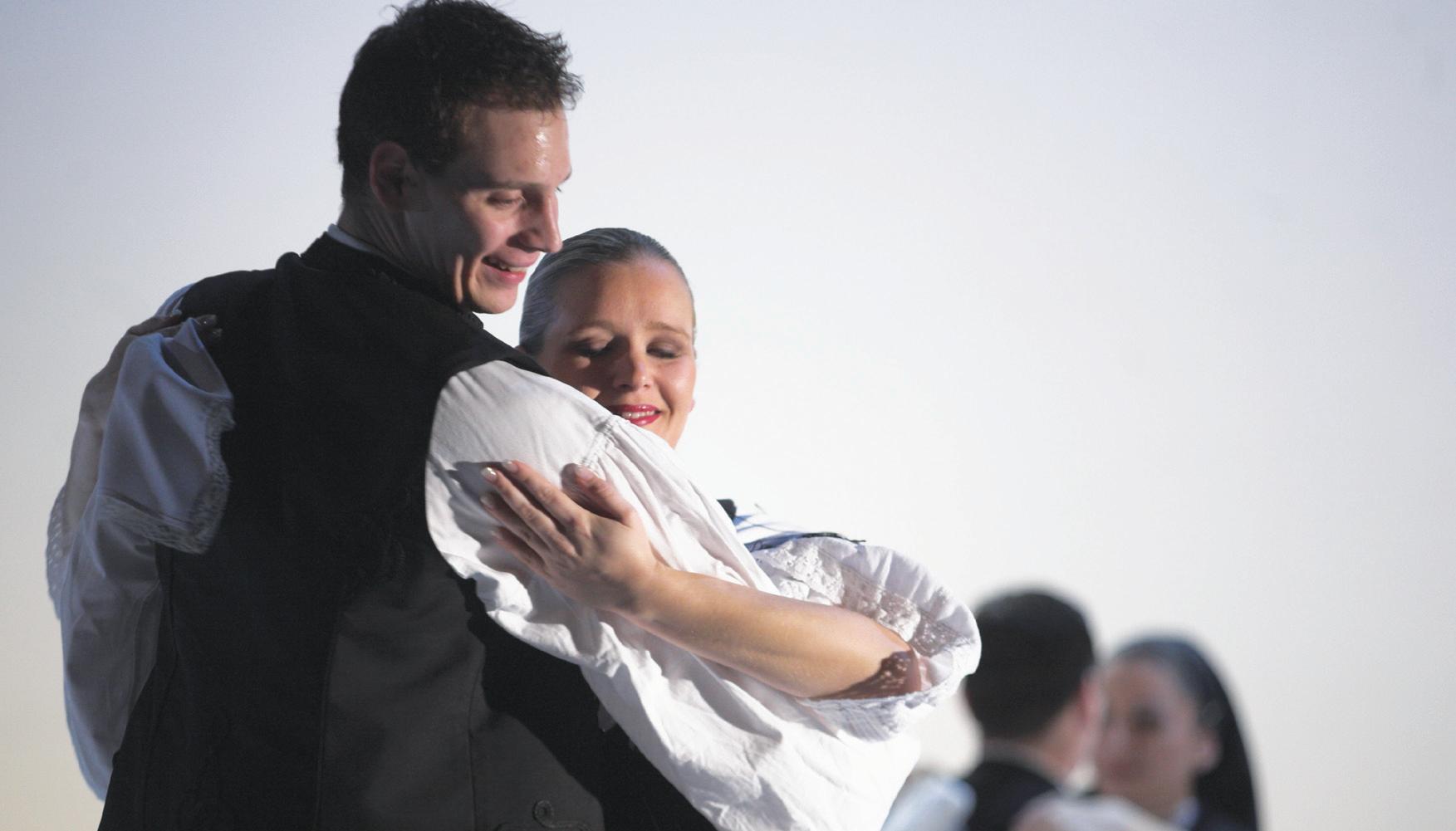
15-16.3.2008
香港文化中心大劇院
Grand Theatre
Hong Kong Cultural Centre
演出長約1小時50分鐘,包括一節20分鐘
中場休息
Running time approximately 1 hour and 50 minutes with a 20 minute interval
Hungarian State Folk Ensemble
Artistic Director’s Biography
為了讓大家對這次演出留下美好的印象,請切記在節目開始前關掉手錶、 無綫電話及傳呼機的響鬧裝置。會場內請勿擅自攝影、錄音或錄影,亦不 可飲食和吸煙,多謝合作。
To make this performance a pleasant experience for the artists and other members of the audience, PLEASE switch off your alarm watches, MOBILE PHONES and PAGERS. Eating and drinking, unauthorised photography and audio or video recording are forbidden in the auditorium. Thank you for your co-operation.
匈牙利國立民族樂團
Hungarian State Folk Ensemble
藝術總監、編舞
加博爾.米哈宜
Artistic Director and Choreographer
Gábor Mihályi
音樂 Music
格傑里.阿哥奇、拉茲魯.凱萊曼、 Gergely Agócs, László Kelemen, 伊斯文.帕爾、費倫斯.雷迪斯
István Pál and Ferenc Radics
指揮 Conductors
伊斯文.帕爾、費倫斯.雷迪斯
István Pál and Ferenc Radics
領唱 Chorus Leader
李察.庫克尼 Richárd Kökény
編舞 Choreography
利塔.弗里克、李察.庫克尼、 Rita Furik, Richárd Kökény, 加博爾.米哈宜、米哈宜.理查茲克 Gábor Mihályi and Mihály Richtarcsik
舞者 Dancers
女舞者
尼古麗塔.班赫伊、尼古麗塔.蓋達 安麗塔.傑拉、杜麗娜.烏西 卡塔琳.賈霍、艾麗絲.康查
蒙妮卡.科斯納、卡拉.庫茲亞 安迪雅.李維、蕭維雅.尼莫斯 卡塔琳.切斯.奧諾迪尼
丹妮娜.帕沛.科斯索 漢麗塔.丹利.雷溫妮 奧索娃.斯特拉克、艾利安娜.蕭拉宜 安迪雅.維斯耶、瑪麗亞.維坦威 男舞者
蓋佛基.艾法伊、蓋佛基.博湖斯 索特.沙巴、拉茲魯.法卡斯 彼得.蓋拉特、諾貝特.古瓦斯 阿帕德.卡利、佐爾坦.吉斯 理查.庫克尼、祖瑟夫.麥基亞 馬克.米哈路維斯、阿提拉.帕維夫 佐爾坦.帕拉基、蕭維斯特.斯肯坦茲 羅伯特.托瓦、彼得.瓦爾加 佐爾坦.小朱拉夫斯基
Female Dancers
Nikoletta Bánhegyi, Nikoletta Gajda
Anita Gera, Dorina Hös
Katalin Jávor, Ágnes Kontra
Mónika Kosina, Klára Kulcsár
Andrea Lévay, Szilvia Nemes
Katalin Csécsi Onodiné
Daniella Pápay-Kószó
Henrietta Dani Radványné
Orsolya Strack, Adrienne Szilágyi
Andrea Visnyei, Mária Vitányi
Male Dancers
György Ágfalvi, György Bohus
Zsolt Csaba, László Farkas
Péter Galát, Norbert Gulyás
Árpád Karé, Zoltán Kis
Richárd Kökény, József Magyar
Márk Mihalovics, Attila Palyov
Zoltán Paragi, Szilveszter Sikentáncz
Róbert Tolvaj, Péter Varga
Zoltán Zsuráfszki Jr
《匈牙利舞曲》:向巴托克致敬
Hungarian Concerto: Hommage à Béla Bartók
父傳子
序曲 —— 向巴托克致敬
旅程記憶
沿河景致
吉卜賽人
擊掌舞
旋轉舞和夏得西舞
男子舞
一起踏上旅程
— 中場休息 —
民族瑰寶
男女對舞
跳躍舞和夏得西舞
自由與塔羅高托管之舞
女子圓環舞
牧人舞
特蘭西瓦尼亞雙人舞
圓環徵兵舞和夏得西舞
尾聲 —— 向巴托克致敬
演出舞目及次序或有更改
From Father to Son
Prologue – Hommage à Béla Bartók
Memory of the Journey
Scenes along the River
Gypsies
Clap Dance
Turn Dance and Csárdás
Men’s Dances
Together on the Journey — Interval —
Our Treasures
A Couple
Jumping Dances and Csárdás
Dance for Voice and Tarogato
Girls’ Round Dance
Shepherds
A Couple from Csíkszék, Transylvania
Circle Verbunk and Csárdás
Epilogue – Hommage à Béla Bartók
Dances and their order of performance are subject to change
加料節目 Festival Plus
工作坊
16.3.2008(日)上午11:00 - 下午1:00 匈牙利國立民族舞蹈團工作坊 香港文化中心大劇院排練室(二)
費用:$250
請情請參閱藝術節加料節目指南,或瀏覽 藝術節網站:www.hk.artsfestival.org
Workshop 16.3.2008 (Sun), 11:00am - 1:00pm
Hungarian State Folk Ensemble Dance Workshop Rehearsal Room 2, Grand Theatre, HK Cultural Centre
Fee: $250
For details please refer to the Festival Plus Booklet or go to the Festival website: www.hk.artsfestival.org
《匈牙利舞曲》:向巴托克致敬
Hungarian Concerto: Hommage à Béla Bartók
二十世紀九十年代的政治動盪令中歐和 東歐出現了一些新興民主國家。對匈牙 利來說,記憶猶新的1956年革命使它迅 速投入這場變革,新的匈牙利共和國由 是誕生。這重大的歷史事件,從根本迅
速地改造了我們的經濟、社會和文化環 境,而我們曾一度依賴、以為永不改變 的傳統,也發生了急劇變化。因此,在 文化傳統的精華完全丟失之前,我們感 到有需要去認識和肯定這些瑰寶,有需 要通過我們的語言在廣大的世界中找到 自己的身份和定位。
匈牙利國立民族舞蹈團的演出融舞蹈和 戲劇於一爐,由民族舞蹈、民族音樂、 當代音樂和新式的劇場處理手法薈萃而
成,成為全球獨一無二的演出:既便於 觀眾各自認同,也彰顯了普遍的價值。
創作者在構思《匈牙利舞曲》過程中, 都受到作曲家、民族音樂學家兼鋼琴家 貝拉·巴托克的作品指引。巴托克的精 神情操和畢生工作,徹底證明了傳統和 現代是相輔相成的力量。瞭解我們本國 的文化、民族舞蹈和民間音樂,就能找 到我們自己獨特、現代而緊貼時勢發展 的藝術表現形式:我們新的舞蹈語言。
因此,《匈牙利舞曲》就體現出傳統和 現代的統一。這點表現於匈牙利民間音 樂和土風舞的多變:有如精湛雜技的男 子舞蹈;熱烈抒情的女子舞蹈;散發愛 情魅力的雙人舞;還有最美妙、最經典 的匈牙利民間音樂作品,既可作純美的 器樂獨奏,也可以是精彩絕倫的合奏曲 目。
《匈牙利舞曲》是一場為新世界創作的 新穎表演。
The political cataclysm of the 1990s resulted in the emergence of several new democracies in Central and Eastern Europe. For Hungary, the living memory of the revolution of 1956 made it an eager protagonist for such change, and a new Hungarian Republic was born. This significant historic event fundamentally and quickly reshaped our economic, social and cultural environment. And the tradition we once relied upon, that we thought could never alter, rapidly changed. As such, we felt the need to identify and affirm the valuable elements of our cultural tradition before they were lost altogether. And we felt the need to identify ourselves and position ourselves in the wider world, through our language.
The Hungarian State Folk Ensemble’s performances are a complex blend of dance and theatre comprising traditional folk dance, folk music, contemporary music and an up-to-date dramaturgy. All of these aspects make our performances unique in the world; facilitating personal identification whilst representing universal values.
Whilst conceiving the Hungarian Concerto , the originators were guided by the oeuvre of the composer, ethno-musicologist and pianist Béla Bartók. His spirituality and life-work convincingly prove that tradition and modernity are complementary forces. In knowing our native culture, folk dances and folk music, we can find our own special, modern and topical form of artistic expression; our new language of dance. As such, the Hungarian Concerto reflects the unity of tradition and modernity. This is expressed through the stunning variations in Hungarian folk music and folk dance; the acrobatic skill of men’s dances; the lyricism of women’s dances; the charm of love reflected in the duets; and the most beautiful, almost classic pieces of Hungarian folk music, played as either fine instrumental solos or tremendous orchestral arrangements.
The Hungarian Concerto is a new performance for a new world…
父傳子
序曲––向巴托克致敬
巴托克《雙小提琴的44個二重奏》節選
旅程記憶
一段時空幻想的旅程,一段互相分享的 旅程記憶。
沿河景致
多瑙河是匈牙利最大的河流,也是歐洲 主要河流,連接起沿岸各種不同文化。
傍河而居的匈牙利人,其舞蹈受到同一 地區其他民族文化的影響。「沿河景 致」再現了匈牙利西部薩爾克茲地區的 斑斕世界,他們有古老的跳躍舞,可追 溯至中世紀、技巧高超的酒瓶舞,還有 獨特的雙人舞。來自匈牙利東部索特馬 爾地區的徵兵舞和夏得西舞,前者是節 拍快速、叫人振奮的男子獨舞,後者則 是傳統變奏雙人舞。
吉卜賽人
吉卜賽人是歐洲的少數民族,最讓人 神往、也最具神秘色彩。他們古老的文 化、男子舞及打情罵俏的雙人舞,使這 段演出獨特原創,可一不可再。
擊掌舞
小提琴和風琴伴奏下的兩組雙人舞, 具有扣人心弦的不對稱節拍,要求高 超技藝,能讓每個舞者透過舞姿盡情 展現自我。
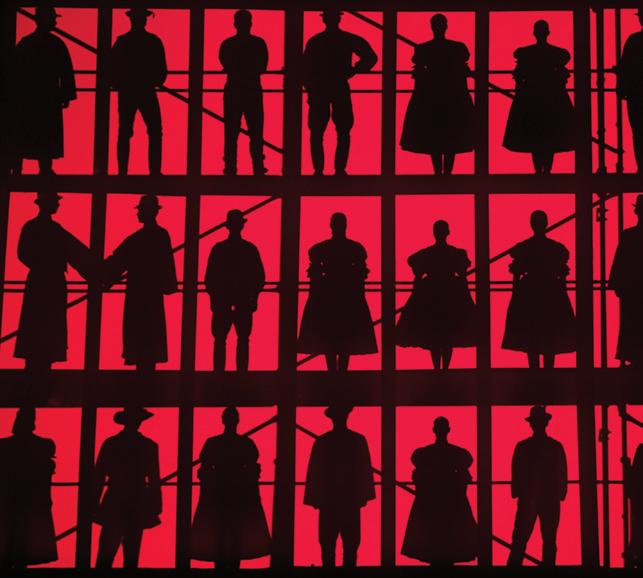
From Father to Son
Prologue - Hommage à Béla Bartók
Excerpt from Forty-four Duos for Two Violins by Béla Bartók
Memory of the Journey
A journey in space, time and fantasy; a memory of the journey shared.
Scenes along the River
Being the largest river in Hungary, and a major river in Europe, the Danube connects different cultures along its course. The dances of the Hungarian’s living along the Danube were influenced by the cultures of other people living in the same region. ‘Scenes along the River’ evokes the colorful world of the Sárköz region of Western Hungary, its archaic jumping dances, skill-demanding bottle dances dating back to the Middle Ages, and unique couple dances. The Verbunk (men’s solo dances) and Csárdás (traditional dances that vary in tempo) from the Szatmár region of Eastern Hungary include a quick and exciting men’s recruiting dance and a couple’s Csárdás.
Gypsies
Gypsies are the most exciting and the most mysterious minority living in Europe. Their ancient culture, their men’s dances and the lyrical and frolicking nature of love displayed in their couple’s dances, make this scene unique, original and unrepeatable.
Clap Dance
Two couples dance accompanied by the violin and bagpipe. The dance has exciting asymmetric rhythms and fine technique, allowing the individuality of each dancer to emerge.
Turn Dance and Csárdás
Due to its political and geographic separation, Transylvania – a region once belonging to preWorld War I Hungary – has preserved an historic culture of dances and music. This scene evokes the men’s dances and couple’s dances from the Mezöség region of Transylvania.
旋轉舞和夏得西舞
第一次世界大戰前屬匈牙利領土的特 蘭西瓦尼亞,由於政治及地理上的隔 絕,保留了一種古老的舞蹈音樂文化。
這演出場景再現了來自特蘭西瓦尼亞 Mezöség地區的男子舞和雙人舞。
男子舞
男子舞是自成一體的舞蹈,而最精湛的匈 牙利男子舞代表了個人土風舞風格的最 新發展。舞姿靈活遒勁、力度節奏變化多 端、表演歎為觀止、含義豐富,都是這些 舞蹈的主要特徵,只有最富經驗的舞者才 能勝任。
一起踏上旅程
我們是變化不息的「世界文化」之一份
子,但我們也是某種特定文化、我們的 根源文化的一部份。這是我們找到社 群的地方⋯⋯,這社群是我們身份的根 源。
—
中場休息 —
民族瑰寶
男女對舞
社群是一種力量,是使整體持續下去的 源泉。這種力量保護群體內所有成員, 向男男女女展示生存之道。
跳躍舞和夏得西舞
這一幕呈現的男子獨舞,可追溯到中世 紀的古代戰舞。這些舞蹈以競技為特 徵,但女舞者的出現將整個場景變成一 幕慶典。旋轉舞和雙人舞夾雜着碎步和 嬉鬧的變化,展示出匈牙利舞蹈文化的 想像天地。
自由與塔羅高托管之舞
塔羅高托管是中世紀匈牙利管樂器,有點 像單簧管。18世紀初,這種樂器被禁,後 來成了為自由而抗爭的象徵。
女子圓環舞
圓環舞和花邊舞在古代人類文明伊始就 發展起來。這見證於舞蹈中豐富的希臘
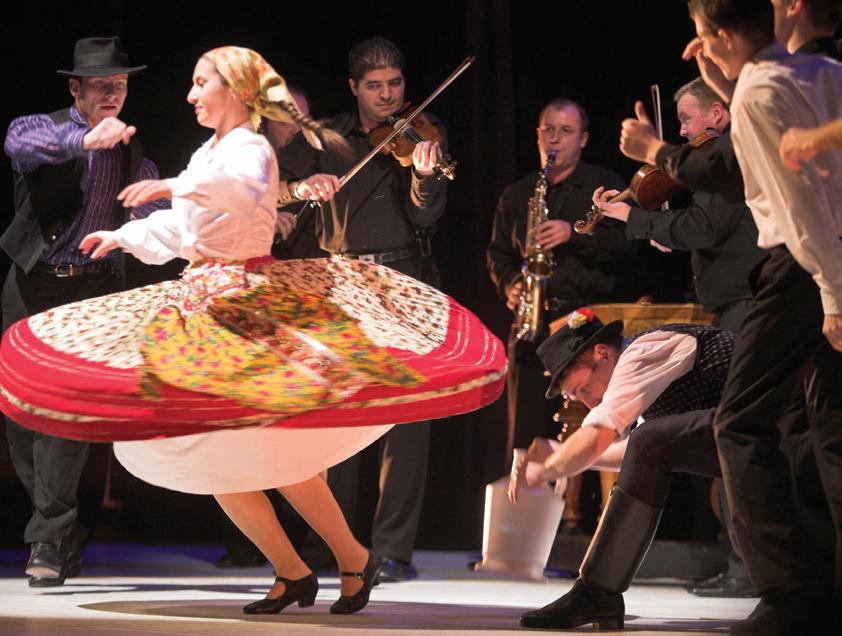
Men’s Dances
Men’s dances are a complete category of dances, and the most virtuoso Hungarian men’s dances represent the last phase of development in individual folk dances. Flexibility and power, varied dynamics and rhythm, as well as devastating and suggestive interpretation are the main features of these dances, and only the most experienced dancers perform them.
Together on the Journey
We are part of an ever-changing global culture. Yet, we are also part of a particular culture, our culture of origin. This is where we find community...and where the community serves as the source of our identity.
— Interval —
Our Treasures
A Couple
Community is a power, the source of persistence. This power protects everyone in the community and shows men and women the way of existence.
Jumping Dances and Csárdás
This scene presents a men’s dance comprising elements of ancient war dances traced back to the Middle Ages. These dances feature skills and rivalry, though the appearance of women transforms the scene into a celebration. The whirling dance and the couple dance, peppered with short steps and playful changes, demonstrate the imaginative world of Hungarian dance culture.
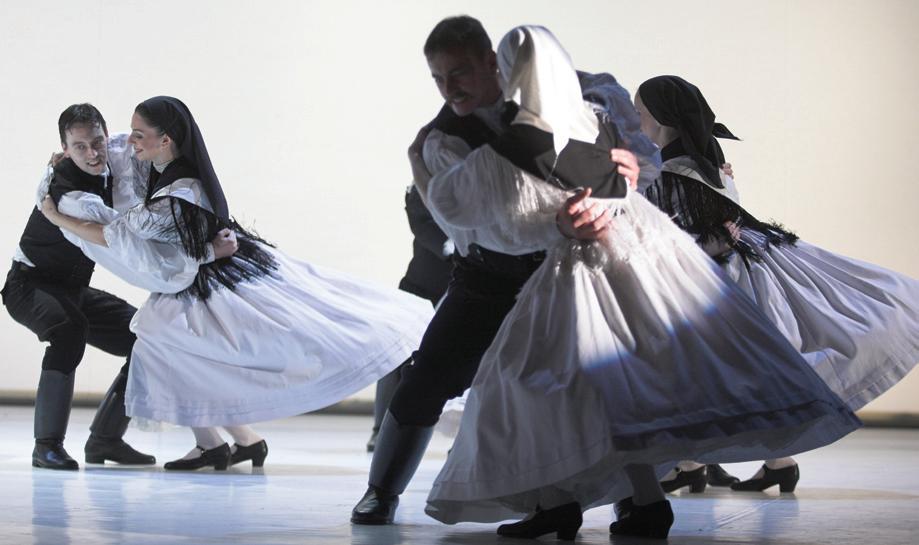
意象及其他地中海地區意象(比如瓶飾 和鑲嵌圖案)。匈牙利女子圓環舞是這 種古老舞風的最新衍變,伴以歌唱,講 述詩情畫意的愛情故事。
牧人舞
在中世紀歐洲舞壇,戰爭舞獨佔鰲頭。
據著名旅行家所記,海達克(牧人)舞 是技巧高超的戰爭舞蹈。直到現在,牧 人仍保存了這種古老舞蹈,雖然精湛舞 藝並未消亡,但舞者已放下昔日的刀 劍,代之以手杖。
特蘭西瓦尼亞Csíkszék雙人舞 該舞蹈由一種喚名 hit-gardon(敲擊提 琴)的獨特樂器伴奏。 hit-gardon 由整 塊樹幹刻製而成,外形在農民看來就像 一個大提琴,屬弦樂器,卻用敲擊法演 奏,所有樂弦定於同一音調。舞者的擊 掌頓足和 hit-gardon 彼此呼應,為舞曲 擊出不落俗套的節奏。
圓環徵兵舞和夏得西舞 從容壯觀的徵兵舞(或稱軍人舞),用 於徵兵期間。它與夏得西舞(雙人舞) 成了匈牙利人性格的最真實寫照,這 兩種舞形式多樣,遍及所有操匈牙利語 的地區。是次演出是將最出色的舞蹈改 編成舞台版本,但仍保留當地舞蹈的神 髓。
尾聲––向巴托克致敬
Dance for Voice and Tarogato
The tarogato is a medieval Hungarian wind instrument resembling the clarinet. In the early 18th century the instrument was banned and became a symbol of the struggle for freedom.
Girls’ Round Dance
Circle and lace dances were developed in Antiquity, at the dawn of human civilisation. This fact can be proven by the abundance of Greek and other Mediterranean imagery (such as vases and mosaics) in the dances. Hungarian women’s circle dances are late descendants of this archaic style and, accompanied by voices, tell poetic tales of love.
Shepherds
The dances of medieval Europe were dominated by war dances. Famous travellers reported that the heyducks’ (herdsmen) dances were extremely skilled and warlike. Until recently, shepherds kept this ancient dance alive and although the virtuosity survived, the swords were laid down and replaced with sticks.
A Couple from Csíkszék, Transylvania
This dance is accompanied by a unique instrument called the hit-gardon. It is carved from a tree trunk, and shaped like a peasant might envision a cello. It is a string instrument played percussively, with all its strings tuned to the same note. The clapping and stomping of the dancer and the sound of the hitgardon are interdependent, and they drive the offbeat rhythm of the dance.
Circle Verbunk and Csárdás
The slow and gallant Verbunk, a dance used during recruitment, and the related Csárdás –– a couple’s dance –– became the most authentic expression of Hungarian character. They are present, in various forms and types, across the whole of the Hungarianspeaking world. In this scene, the most outstanding dances are adapted for the stage, but remain similar to the original, authentic dances.
Epilogue – Hommage à Béla Bartók
匈牙利國立民族舞蹈團
The Hungarian State Folk Ensemble
匈牙利國立民族舞蹈團成立於1951年, 是匈牙利優秀樂舞團之一。從一開始, 該團就致力收集、表演正宗的民間音 樂,保留匈牙利民間舞蹈和傳統服飾, 再搬上舞台與眾同樂。
創團 57 年來,舞蹈團不僅使匈牙利民族 文化得以復興,更憑着豐富多彩的表演 節目,躋身世界頂尖巡演團體。舞蹈團 演遍四大洲 44 個國家,贏得全球近 800 萬觀眾讚譽。舞蹈團在加拿大和美國大 受歡迎,並於1994年在美國舉辦為期三 個月的巡演,也曾於遠東和西歐演出。 除了演遍國內外,舞蹈團還在其駐團基 地––布達佩斯布達娛樂城柯雲廣場劇 院,每年演出上百場。
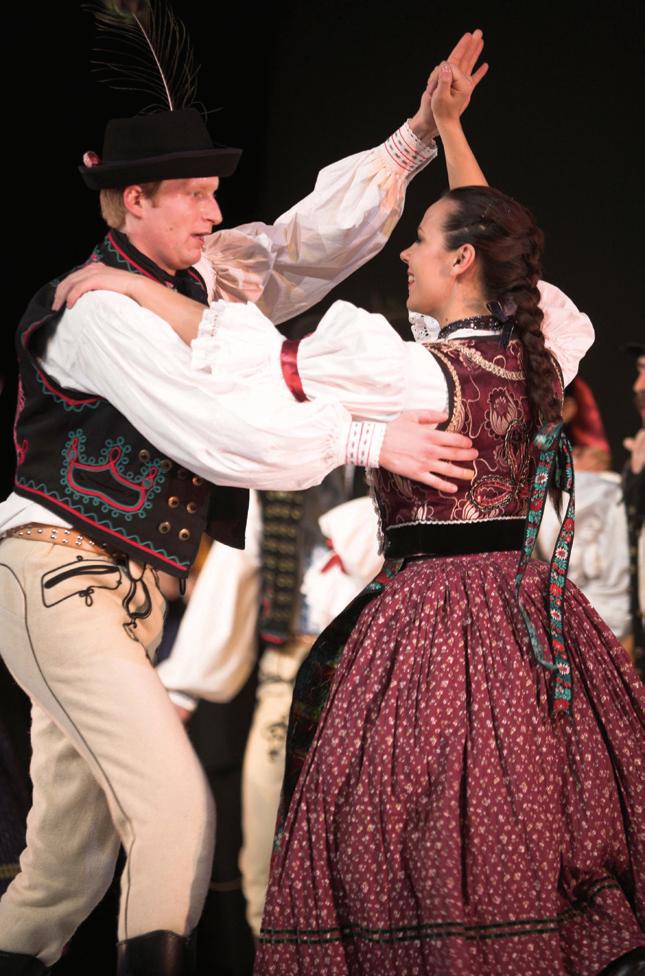
The Hungarian State Folk Ensemble was established in 1951 and is regarded as one of the best music and dance ensembles in Hungary. From the outset, its aim has been to collect and play authentic folk music and to preserve the Hungarian folk dances and traditional costumes by putting them on stage for all to enjoy.
During the 57 years of its existence, the Ensemble has not only revitalised the culture of the Hungarian people but, through its rich and colourful repertoire, established itself as one of the top touring groups in the world. The Ensemble has performed in 44 countries, across four continents and won the admiration of a world-wide audience of more than seven-and-a-halfmillion. It was so well received in the United States and Canada that in 1994 it made a three-month coast to coast tour of the US. It has also toured the Far East and Western Europe. Aside from its performances around Hungary and abroad, the Ensemble gives almost one hundred annual performances at its residence, the Corvin tér Theatre in the Budai Vigadó, Budapest.
The Hungarian State Folk Ensemble comprises 30 dancers who interpret choreographies based on authentic dances, many of which were collected from isolated villages and involve dance elements dating back hundreds of years. The Ensemble’s musicians comprise nine members of the world famous Hungarian Gypsy Orchestra and five members of the Hungarian Folk Orchestra. The Hungarian Folk Orchestra musicians play authentic, traditional instruments and perform Hungarian folk music at its highest artistic level. The Hungarian Gypsy Orchestra musicians play dance accompaniments. Together, their rich repertoire includes the extraordinary folk music that inspired Franz Liszt, Béla Bartók and Zoltán Kodály.
匈牙利國立民族舞蹈團旗下共有 30 名舞 蹈演員,他們立足原本的舞蹈,以之編 舞,其中多數舞蹈是從偏僻村莊收集而 來,帶有數百年前的舞蹈元素。樂師中 有九名來自聞名世界的匈牙利吉卜賽交 響樂團,另有五名來自匈牙利民族交響 樂團。匈牙利民族交響樂團的樂師演奏 正宗的傳統樂器,以最高水準的匈牙利 民族音樂獻藝。匈牙利吉卜賽交響樂團 的樂師則為舞蹈伴奏。兩個樂團連袂呈 獻豐富多彩的保留曲目,其中非凡的民 間音樂,曾啟發了李斯特、巴托克和高 大宜等大師。
民俗
將民俗搬上舞台,這在匈牙利人的文化 生活中比較新鮮。 20 世紀 50 年代,專
業民族舞蹈團紛紛建立,將這種演出制 度化,匈牙利國立民族舞蹈團也於此時 崛起。自創團之始,舞蹈團旨在扶持傳 統、使之再現舞台,除了炮製原汁原味 而富有教益的舞蹈演出外,舞蹈團一直 期望有朝一日能成立一家獨立的舞蹈劇 場。而舞台上民族舞蹈藝術的真正復 興,乃始於 70 年代初,源自舞場運動。 當時,專業土風舞團開始在節目中加入 真實地道的素材。以更具舞台效果的動 作來改造或替代原有舞蹈的方法,已不 再給人奉為圭臬了。只有對真實原本的 舞蹈精準重現,才是正確之道。
20世紀最後10年間,匈牙利國立民族舞 蹈團致力實踐這些藝術理念。傳統民族 舞蹈以各種面貌在舞台展現:既作為主 題,又可作為表達主題的手段。無論哪 種形式,民俗已表現出其中的無限創意 和勃勃生機,成為匈牙利當代藝術調色 板上的一抹亮色。
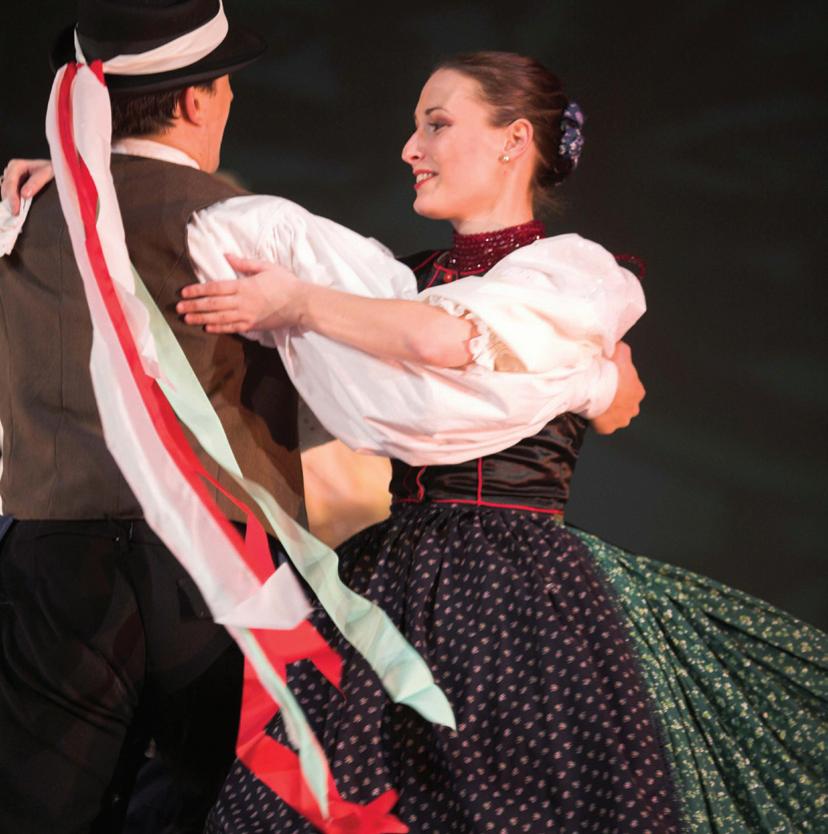
Folklore
Folklore on stage is a relatively new phenomenon in Hungarian cultural life. It was institutionalised through the establishment of professional folk dance ensembles in the 1950s when the Hungarian State Folk Ensemble was also established. Right from the beginning, the Ensemble’s function was to patronise and visualise tradition on stage and to some day establish an independent dance theatre.
The real revival of folk dancing on stage came at the beginning of the 1970s, emerging from the dance-house movement. At that time professional folk dance ensembles began to include authentic themes in their repertoire. Transformation and the substitution of original dance figures with more ‘stagelike movements’ was no longer a guiding principle, and only precise reproduction of the dances was deemed correct.
In the last decade the Hungarian State Folk Ensemble has managed to work through these artistic ideals. Traditional folk dances appear in their performances in various aspects; either as the theme itself or the instrument through which the theme is expressed. Either way, folklore has proven its creativity and vitality and has become a vibrant colour in the palette of Hungarian contemporary arts.
